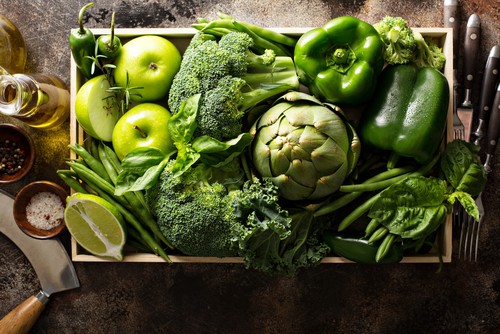Share this post
Why fruits, berries, and veggies should be a staple in any diet
“Crackers and cheese, that’s about all he eats,” a mom tells me when I ask her about her child’s eating habits. “Hm, I see. Any vegetables?” “Only if I put them in the blender and sneak them into tomato sauce.” We both shrug our shoulders, laugh, and spend the rest of the visit talking about ways to hide more nutrients in the kiddo’s cuisine.
Conversations like this one happen all too often in my family practice.
Adults might become impatient with these adorable little ones who refuse to eat plants, but let’s consider our own diets for a moment. How many greens are we eating? Likely not enough.
Even those of us eating “clean” diets could stand to up our vegetable intake. For example, those following a paleo or ketogenic diet might eat a plate of protein for dinner, use vegetables as a mere garnish, and then wonder why they’re constipated. Even vegans often have a curiously low intake of vegetables, opting for plant-based protein bars, nuts, rice noodles, and tofu. When it comes to nutritional status, it isn’t so much what we take out of diet as it is what we put in. And the vast majority of us could benefit from more fruits and veggies!
It is widely accepted that a diet rich in plants decreases the risk of coronary artery disease (CAD), heart attack, and stroke,[1] improving life quality and length. In fact, a 2013 cohort study of 71,706 participants (38,221 men and 33,485 women) aged 45 to 83 years found that those who seldom ate fruits and vegetables lived on average three years less and had a 53% higher mortality rate than those who consumed five servings of fruits and vegetables daily. In another study following 10,000 middle-aged men over four decades, increased consumption of vegetables, fruits, and berries was found to delay overall death and decrease the risk of all-cause mortality, in particular with respect to cancer and cardiovascular disease.[3]
Those who seldom ate fruits and vegetables lived on average three years less and had a 53% higher mortality rate than those who consumed five servings of fruits and vegetables daily.
Although virtually all fruits and vegetables are beneficial for health, some plant-based superfoods worth celebrating (and eating!) include the following:
Acerola cherries are berry good
The healing benefits of berries largely come from the flavonoids they contain. Flavonoids are phytonutrients that have antioxidant activity, thus making them significant players in improving cardiovascular health and preventing cancer caused by free radical damage. A Swedish cohort study found that eating berries had a direct impact on reducing stroke risk in those with high blood pressure,[4] and an American study found a similar association with respect to cardiovascular disease.[5] Berries are also celebrated for their rich vitamin content. Acerola cherries in particular are rich in vitamin C, containing more vitamin C than all other food sources according to the United State Department of Agriculture (USDA).[6] In fact, fresh acerola cherry juice contains 13 times more vitamin C than orange juice.
Fresh acerola cherry juice contains 13 times more vitamin C than orange juice.
One cup of acerola juice also contains 1,232 international units (IU) of vitamin A – double that of the same portion of fresh berries.[7] If berries pack a nutritional punch, acerola cherries pack health-boosting dynamite!
Leaves of (wheat) grass
Wheat, barley, alfalfa, oat, and many other grains are actually grasses, existing as young green plants before they produce grain. These young cereal grasses, as they are known, have very different chemical and nutritional composition from the mature seed grains they produce. In particular, the grasses are much higher not only in protein, but also in vitamins A, C, and E, as well as iron, magnesium, calcium, and chlorophyll. (More on chlorophyll in a minute.)[8],[9] Wheat grass juice also lowered cholesterol markers as effectively as statin drugs in a study done on rats,[10] and another trial found it significantly lowered blood sugar levels.[11] Those with wheat and gluten sensitivities typically tolerate the grasses of these grains just fine, as the grasses themselves are gluten-free.
Immune-boosting algae
Chlorella is a green freshwater algae rich in protein, chlorophyll, RNA, DNA, and carotenoids. Chlorella has long been celebrated for its health-boosting effects, from easing inflammation[12] to strengthening the body’s ability to ward off infections.[13] Chlorella has also been shown to fight allergies by suppressing histamine release[14] and has even been shown to kill cancer cells.[15],[16] Considering the tough cell wall of this plant, many manufacturers grind chlorella into small pieces to improve absorption, but this practice sadly dissipates many of chlorella’s important nutrients. More carefully created products involve a fracturing or “cracking” process to preserve the nutrients contained within the cells and to enhance their absorbability after ingestion.
Both cereal grasses and chlorella are rich in chlorophyll,[17] a pigment essential for photosynthesis, the process by which plants create energy from sunlight. In humans, chlorophyll acts as a powerful antioxidant with anti-inflammatory properties,[18] and may thus be of benefit in preventing and mitigating heart disease,[19] arthritis, and neurodegenerative diseases such as Parkinson’s.[20] Chlorophyll has also been shown to both prevent cellular mutations and changes which precede the development of cancer.[21],[22],[23] Diets that are high in red meat and low in green vegetables are associated with increased colon cancer risk;[24] chlorophyll-rich greens may help mitigate that risk.[25] Chlorophyll also has been shown to support liver detoxification[26],[27] and to promote healthy weight loss.[28],[29],[30]
Supplementing stripped soil
Even those who eat a diet rich in vegetables may still be vulnerable to sub-optimal nutritional status, in large part due to the loss of phytonutrients in the soil.[31] The increased concentration of pesticides, herbicides, heavy metals, and other environmental toxins in the soil has compromised the healing potential of our food supply. This is where high-quality greens as nutritional supplements can quickly and conveniently help give our bodies a significant nutritional upgrade.
Click here to see References
[1] Perk J, et al. European guidelines on cardiovascular disease prevention in clinical practice (version 2012): the fifth joint task force of the European society of cardiology and other societies on cardiovascular disease prevention in clinical practice. Int J Behav Med 2012;19(4):403-488.
[2] Bellavia A, et al. Fruit and vegetable consumption and all-cause mortality: a dose-response analysis. Am J Clin Nutr. 2013 Aug;98(2):454-9.
[3] Hjartåker A, et al. Consumption of berries, fruits and vegetables and mortality among 10,000 Norwegian men followed for four decades. Eur J Nutr. 2015 Jun;54(4):599-608.
[4] Larsson SC, et al. Total and specific fruit and vegetable consumption and risk of stroke: a prospective study. Atherosclerosis 2013;227(1):147-152.
[5] Mink PJ, et al. Flavonoid intake and cardiovascular disease mortality: a prospective study in postmenopausal women. Am J Clin Nutr. 2007;85(3):895-909.
[6] Basic Report: 09001, Acerola, (west indian cherry), raw. United States Department of Agriculture
Agricultural Research Service. National Nutrient Database for Standard Reference Legacy Release. https://ndb.nal.usda.gov/ndb/foods/show/301023. Accessed online 24 July 2018.
[7] Vendramini, A. Chemical composition of acerola fruit (Malpighia punicifolia L.) at three stages of maturity. Food Chemistry. 2000;71(2):195-198.
[8] Wangcharoen W, Phimphilai S. Chlorophyll and total phenolic contents, antioxidant activities and consumer acceptance test of processed grass drinks. J Food Sci Technol. 2016 Dec;53(12):4135-4140.
[9] Bar-Sela G, et al. The Medical Use of Wheatgrass: Review of the Gap Between Basic and Clinical Applications. Mini Rev Med Chem. 2015;15(12):1002-10.
[10] Kothari S, et al. Hypolipidemic effect of fresh Triticum aestivum (wheat) grass juice in hypercholesterolemic rats. Acta Pol Pharm. 2011 Mar-Apr;68(2):291-4.
[11] Mohan Y, et al. Antidiabetic and antioxidant properties of Triticum aestivum in streptozotocin-induced diabetic rats. Advances in Pharmacological Sciences. 2013;2013:716073.
[12] Sibi G, Rabina S. Inhibition of pro-inflammatory mediators and cytokines by chlorella vulgaris extracts. Pharmacognosy Res. 2016 Apr-Jun;8(2):118-22.
[13] Kwak JH, et al. Beneficial immunostimulatory effect of short-term Chlorella supplementation: enhancement of natural killer cell activity and early inflammatory response (randomized, double-blinded, placebo-controlled trial). Nutr J. 2012 Jul 31;11:53.
[14] Bae MJ, et al. Inhibitory effect of unicellular green algae (Chlorella vulgaris) water extract on allergic immune response. J Sci Food Agric. 2013 Sep;93(12):3133-6.
[15] Zhang ZD, et al. Chlorella vulgaris induces apoptosis of human non-small cell lung carcinoma (NSCLC) cells. Med Chem. 2017;13(6):560-568.
[16] Lin PY, et al. Chlorella sorokiniana induces mitochondrial-mediated apoptosis in human non-small cell lung cancer cells and inhibits xenograft tumor growth in vivo. BMC Complement Altern Med. 2017 Feb 1;17(1):88.
[17] Sethi J, et al. Antioxidant effect of Triticum aestivium (wheat grass) in high-fat diet-induced oxidative stress in rabbits. Methods Find Exp Clin Pharmacol. 2010 May;32(4):233-5.
[18] Subramoniam A, et al. Chlorophyll revisited: anti-inflammatory activities of chlorophyll a and inhibition of expression of TNF-α gene by the same. Inflammation. 2012 Jun;35(3):959-66.
[19] Lin KH, et al. Chlorophyll-related compounds inhibit cell adhesion and inflammation in human aortic cells. J Med Food. 2013 Oct;16(10):886-98.
[20] Pham-Huy LA, et al. Free radicals, antioxidants in disease and health. Int Jour Biomel Sci. 2008;4(2):89-96.
[21] Gore RD, et al. Wheatgrass: green blood can help to fight cancer. JCDR. 2017;11(6):ZC40-ZC42.
[22] Alitheen NB, et al. Cytotoxic effects of commercial wheatgrass and fiber towards human acute promyelocytic leukemia cells (HL60). Pak J Pharm Sci. 2011 Jul;24(3):243-50.
[23] de Vogel J, et al. Green vegetables, red meat and colon cancer: chlorophyll prevents the cytotoxic and hyperproliferative effects of haem in rat colon. Carcinogenesis. 2005 Feb;26(2):387-93.
[24] Aykan NF. Red meat and colorectal cancer. Oncol Rev. 2015 Dec 28;9(1):288.
[25] Pan P, et al. Colon cancer: what we eat. Surg Oncol Clin N Am. 2018 Apr;27(2):243-267.
[26] Egner PA, et al. Chlorophyllin intervention reduces aflatoxin-DNA adducts in individuals at high risk for liver cancer. Proc Natl Acad Sci U S A. 2001 Dec 4;98(25):14601-6.
[27] Yun CH, et al. Non-specific inhibition of cytochrome P450 activities by chlorophyllin in human and rat liver microsomes. Carcinogenesis. 1995 Jun;16(6):1437-40.
[28] Stenblom EL, et al. Supplementation by thylakoids to a high carbohydrate meal decreases feelings of hunger, elevates CCK levels and prevents postprandial hypoglycaemia in overweight women. Appetite. 2013 Sep;68:118-23.
[29] Köhnke R, et al. Thylakoids suppress appetite by increasing cholecystokinin resulting in lower food intake and body weight in high-fat fed mice. Phytother Res. 2009 Dec;23(12):1778-83.
[30] Montelius C, et al. Body weight loss, reduced urge for palatable food and increased release of GLP-1 through daily supplementation with green-plant membranes for three months in overweight women. Appetite. 2014 Oct;81:295-304.
[31] Bormann FH, et al. Nutrient loss accelerated by clear-cutting of a forest ecosystem. Science. 1968;159(3817),882-884.
The information provided is for educational purposes only. Consult your physician or healthcare provider if you have specific questions before instituting any changes in your daily lifestyle including changes in diet, exercise, and supplement use.
Share this post
Dr. Erica Zelfand
Related posts
The Bone and Joint Benefits of Boron
The oft neglected trace mineral and its importance for bone and joint health Meet boron, atomic number 5, “a dynamic trace element affecting an exceptionally large number of seemingly unrelated biological functions,” according to a 2017 review.[1] Despite this broad statement of the importance of boron for potentially every system in the body, study…
What are Antioxidants?
How Do Antioxidants Support Healing? Certain foods – including beautifully-marketed “superfoods” – are celebrated for their antioxidant properties. But what does that even mean? What are antioxidants, and why are they important? What is oxidation? Oxidative stress? As the name implies, antioxidants fight oxidation. But what is oxidation? Let’s take a closer look: If…
Chios Mastiha in the News
Scientists discover further infection-fighting properties of Chios mastic gum Chios mastic gum (CMG) is an aromatic resin produced from the mastic tree, Pistacia lentiscus var. Chia, which is mainly grown on the island of Chios, Greece. It has been used as a natural remedy for stomach and intestinal disorders for more than 2500 years.[1]…
Ways to Ease Inflammation and Depression
Smart lifestyle choices for a happy brain and healthy mood In last week’s post we explored the ways in which inflammation can cause depression. The science shows that we cannot blame genetics alone for depression. That’s a good thing: it means there is a lot we can do to heal our brains. Here are…
Selenium and Immunity
How this trace mineral supports immune system function Winter is just around the corner – is your immune system up to snuff? (Or sniffles!) The seasonality of infectious diseases is well established,[1],[2] as any of us who have suffered from the flu can attest. All nutrients are required in greater quantity during an infection,…
When More Testosterone Doesn’t Help Erectile Health – Part 1 of 2
The role of vascular health on male sexual function “I’m injecting 150 mg of testosterone cypionate every week. I look muscular. I have lots of energy – so much I actually need to take sleeping pills to wind down at night. So why can’t I get a good erection? What is wrong with me?”…
Categories
- Botanicals (56)
- GI Health (53)
- Healthy Aging (121)
- Immune Support (39)
- In The News (39)
- Kids Health (21)
- Stress and Relaxation (50)
- Uncategorized (1)
- Video (9)
- Vitamins & Minerals (51)




